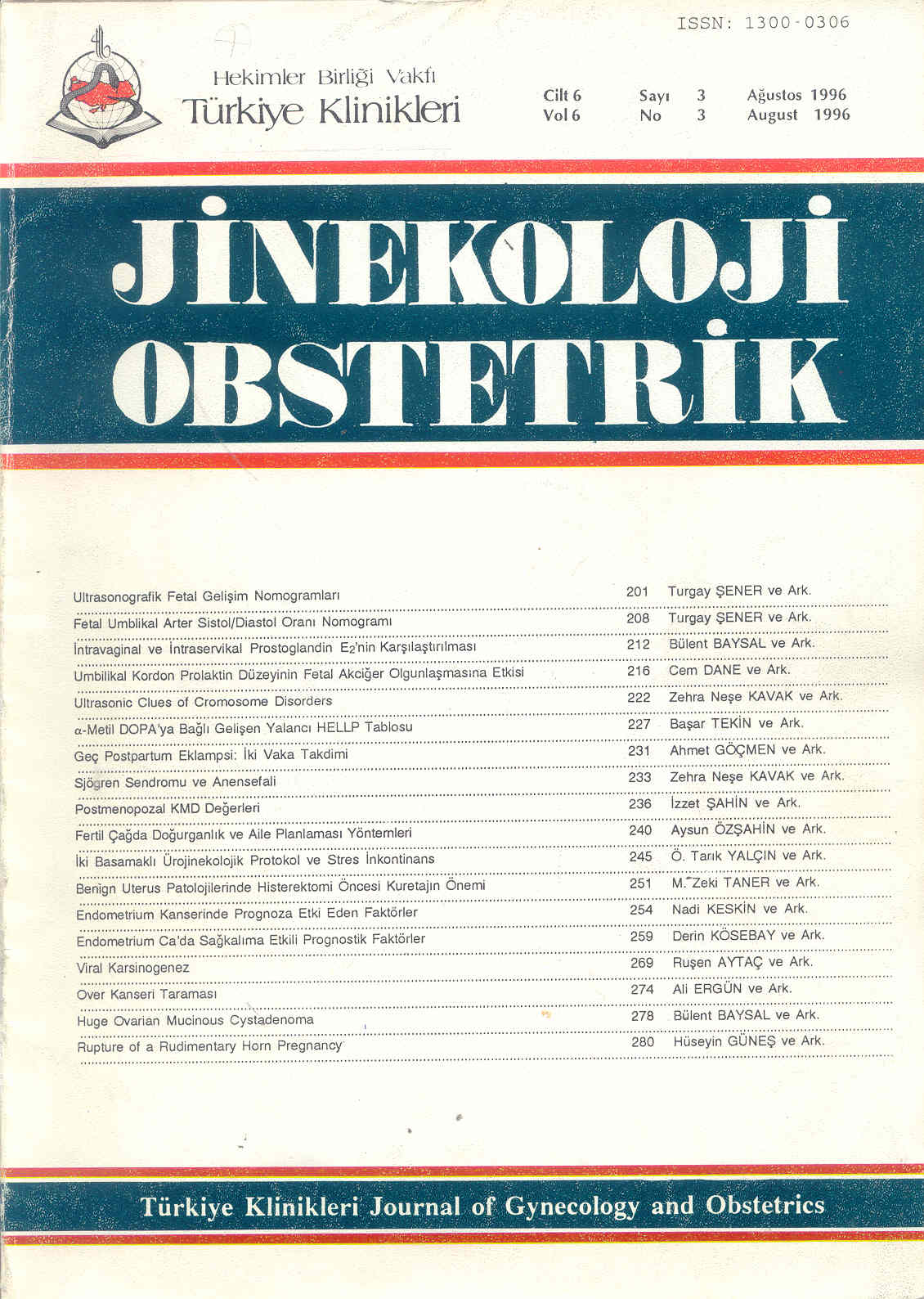Open Access
Peer Reviewed
ARTICLES
3032 Viewed1522 Downloaded
Evaluation Of The Patients With Urinary Incontinence By Two Step Urogynecologic Protocol
Üriner İnkontinansı Olan Hastaların İki Basamaklı Ürojinekolojik Protokol ile Değerlendirilmesi
Turkiye Klinikleri J Gynecol Obst. 1996;6(3):245-50
Article Language: TR
Copyright Ⓒ 2025 by Türkiye Klinikleri. This is an open access article under the CC BY-NC-ND license (http://creativecommons.org/licenses/by-nc-nd/4.0/)
ÖZET
Amaç: Üriner inkontinansı olan hastalarda inkontinans tipinin belirlenmesi. Çalışmanın yapıldığı yer: Osman Gazi Üniversitesi Tıp Fakültesi Kadın Hastalıkları ve Doğum Anabilim Dalı. Materyal ve Metod: Üriner inkontinansı olan 63 hasta iki basamaklı ürojinekolojik protokol ile değerlendirildi. Bulgular: Birinci basamak sonrası 6 (%9.5) hastada üriner enfeksiyon saptanırken, 3 (%4.7) hastada inkontinansın sosyal ya da hijenik bir problem olacak kadar belirgin olmadığı gözlendi. İkinci basamakta değerlendirilen 54 hastanın 13'ünde (%24.2) sadece detrusör instabilitesi, 6'sında (%44.1) sadece anatomik stres inkontinans, 12'sinde (%22.2) miks tip inkontinans saptanırken, 3 (%5.5) hastada inkontinans nedeni olarak belirgin ürojinekolojik anormallik gözlenmedi. Sonuç: İki basamaklı ürojinekolojik protokol ile üriner inkontinansı olan hastaların %94.4'ünde inkontinansın tipi belirlenip, uygun tedaviler uygulandı.
Amaç: Üriner inkontinansı olan hastalarda inkontinans tipinin belirlenmesi. Çalışmanın yapıldığı yer: Osman Gazi Üniversitesi Tıp Fakültesi Kadın Hastalıkları ve Doğum Anabilim Dalı. Materyal ve Metod: Üriner inkontinansı olan 63 hasta iki basamaklı ürojinekolojik protokol ile değerlendirildi. Bulgular: Birinci basamak sonrası 6 (%9.5) hastada üriner enfeksiyon saptanırken, 3 (%4.7) hastada inkontinansın sosyal ya da hijenik bir problem olacak kadar belirgin olmadığı gözlendi. İkinci basamakta değerlendirilen 54 hastanın 13'ünde (%24.2) sadece detrusör instabilitesi, 6'sında (%44.1) sadece anatomik stres inkontinans, 12'sinde (%22.2) miks tip inkontinans saptanırken, 3 (%5.5) hastada inkontinans nedeni olarak belirgin ürojinekolojik anormallik gözlenmedi. Sonuç: İki basamaklı ürojinekolojik protokol ile üriner inkontinansı olan hastaların %94.4'ünde inkontinansın tipi belirlenip, uygun tedaviler uygulandı.
ANAHTAR KELİMELER: Detrusör instabilitesi, anatomik stres inkontinans, miks tip inkontinans
ABSTRACT
Objective: Identifying the type of incontinence in patients with urinary incontinence. Instution: Osman Gazi University Faculty of Medicine Department of Obstetric and Gynecology. Material and Methods: 63 patients with urinary incontinence evaluated by two step urogynecologic protocol. Results: After the first step evaluation urinary infection was diagnosed in 6 (9.5%) patients while significant urinary incontinence was not observed as being a social or hygienic problem in 3 (4.7%) patients. Of the remaining 54 patients evaluated in the second step, it was identified that 13 (24.2%) had pure detrusor instabiliy, 26 (48.1%) had pure anatomic stress incontinence, 1 (22.2%) had mixed type incontinence and 3 (5.5%) had no significant urogynecologic abnormality as a cause of incontinence. Conclusion: Type of incontinence could be identified in 94.4% of the patients with urinary incontinence and aproppriate treatments were given by using two step urogynecology protocol.
Objective: Identifying the type of incontinence in patients with urinary incontinence. Instution: Osman Gazi University Faculty of Medicine Department of Obstetric and Gynecology. Material and Methods: 63 patients with urinary incontinence evaluated by two step urogynecologic protocol. Results: After the first step evaluation urinary infection was diagnosed in 6 (9.5%) patients while significant urinary incontinence was not observed as being a social or hygienic problem in 3 (4.7%) patients. Of the remaining 54 patients evaluated in the second step, it was identified that 13 (24.2%) had pure detrusor instabiliy, 26 (48.1%) had pure anatomic stress incontinence, 1 (22.2%) had mixed type incontinence and 3 (5.5%) had no significant urogynecologic abnormality as a cause of incontinence. Conclusion: Type of incontinence could be identified in 94.4% of the patients with urinary incontinence and aproppriate treatments were given by using two step urogynecology protocol.
MENU
POPULAR ARTICLES
MOST DOWNLOADED ARTICLES





This journal is licensed under a Creative Commons Attribution-NonCommercial-NoDerivatives 4.0 International License.










